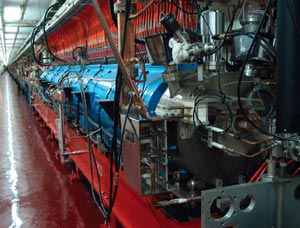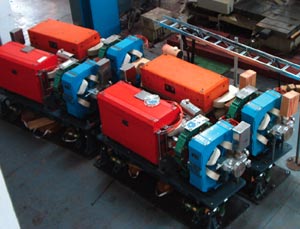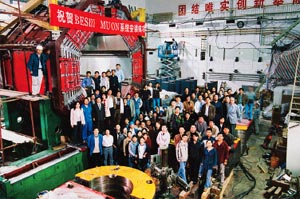A recent collaboration gathered to hear the latest news on the upgrades to the Beijing Electron-Positron Collider and to the Beijing Spectrometer.
The Institute of High Energy Physics (IHEP) in Beijing is looking forward to a new era as construction of the upgraded Beijing Electron-Positron Collider (BEPC) moves into its final stage.

The BEPC II linac is now in place and installation of the storage ring has started. At the same time, the muon identifier and the superconducting magnet have been installed in the third incarnation of the Beijing Spectrometer (BES III). This was therefore an important time for the BES III collaboration meeting held in January, during which new members from GSI and the universities of Giessen and Bochum were accepted, and a new organizational structure of the collaboration was formally adopted.
BEPC II is a two-ring e+e– collider running in the tau-charm energy region (Ecm = 2.0-4.2 GeV), which, with a design luminosity of 1 × 1033 cm-2s-1 at the beam energy of 1.89 GeV, is an improvement of a factor of 100 over its successful predecessor, BEPC. The upgrade will use the existing tunnel, some major infrastructure items, and some of the old magnets. The 202 m long linac of the new machine can accelerate electrons and positrons up to 1.89 GeV with a positron injection rate of 50 mA/min. Its installation was completed in the summer of 2005 and it has reached most of the design specifications.

The collider consists of two 237.5 m long storage rings, one for electrons and one for positrons. They collide at the interaction point with a horizontal crossing angle of 11 mrad and a bunch spacing of 8 ns. Each ring holds 93 bunches with a beam current of 910 mA. The machine will also provide a high flux of synchrotron radiation at a beam energy of 2.5 GeV. The manufacture of major equipment such as magnets, superconducting RF cavities (with the co-operation of the Japanese high-energy physics laboratory, KEK, and the company MELCO) and quadrupole magnets (with the co-operation of the Brookhaven National Laboratory), as well as the cryogenics system, have been completed, and their installation is under way. The pre-alignment of magnets has made good progress. Figure 2 shows the mock-up of the installation of four pre-alignment units in the tunnel. Actual installation in the tunnel will begin soon and beam collisions are expected in the spring of 2007.
The BES III detector consists of a helium-based, small-celled drift chamber, time-of-flight (TOF) counters for particle identification, a calorimeter of thallium-doped caesium iodide CsI(Tl) crystals, a super-conducting solenoidal magnet with a field of 1 T, and a muon identifier that uses the magnet yoke interleaved with resistive plate counters (RPCs). Figure 3 shows a perspective view of the detector.

The wiring of the drift chamber has been completed, and the assembly of the chamber has started. Beam tests of prototypes have been performed at KEK and IHEP with electronics prototypes, and both tests show that all design specifications have been satisfied and that the single wire resolution is 110 μm. CsI(Tl) crystals are being produced by Saint-Gobain Crystals, by the Shanghai Institute of Ceramics, and by Hamamatsu (Beijing). More than two-thirds of the crystals have been delivered, with satisfactory light yield, uniformity and radiation hardness. A beam test shows that the electronics noise from the preamplifier, main amplifier, charge digitizer and 18 m of cable was less than 1000 electrons equivalent per crystal, corresponding to about 220 keV of energy.
The scintillator and phototubes for the TOF system will be delivered before summer. All the RPCs for the muon identifier, made of bakelite but without the linseed oil surface treatment, have been manufactured, tested, and installed (figure 4). The average dark current and noise level for all chambers installed after one week’s training is 1.6 μA/m2 and 0.095 Hz/cm2, respectively, for a high voltage corresponding to an average efficiency of 95%.

The BES III superconducting magnet is the first of its kind built in China. The vacuum cylinder and the supporting cylinder are made in China, in collaboration with the Wang NMR company of California. The wiring of the superconducting cable and the epoxy curing, the assembly and testing were all done at IHEP, with advice from experts all over the world. The superconducting magnet coil has now been successfully installed into the detector (figure 5) and will be cooled soon.

The latest BES III collaboration meeting was held on 10-12 January at IHEP. More than a hundred collaborators attended the meeting, coming from 21 institutions in 5 countries, namely China, Germany, Japan, Russia and the US. The meeting reviewed the current status of the BES III construction and discussed technical details. The collaboration accepted new groups as members, including teams from GSI, the University of Bochum and the University of Giessen, all from Germany. This meeting was also historic as the governance rules of the collaboration were approved and used for the first time. Under these rules, the Institutional Board was established and Hongfang Chen from the University of Science and Technology of China was elected as the chair, with Weiguo Li from IHEP chosen as deputy chair. Yifang Wang from IHEP was elected as spokesperson, and Yuanning Gao from Tshinghua University and Frederick Harris from the University of Hawaii were elected as co-spokespersons. The next collaboration meeting is scheduled to be held at IHEP on 8-9 June, immediately after the Charm 2006 workshop on 5-7 June, also at IHEP.





